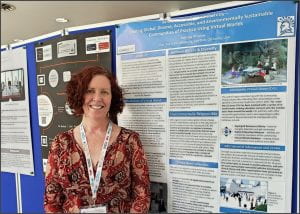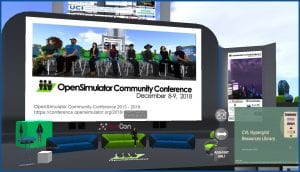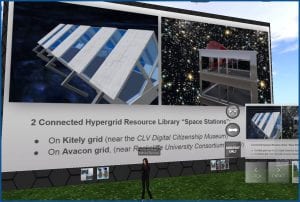I recently joined my Community Virtual Library and SJSU’s VCARA colleagues at a fun event held at iSchool Island in Second Life. We held a Virtual Reality vs Virtual Worlds Smackdown Debate, complete with our impressive avatars ready to duke it out for the audience!
Our sparring was moderated by Dr. Valerie Hill, the director of the Community Virtual Library in Second Life, Avacon, and Kitely. We each had five minutes to speak, and then five minutes to refute our opponent’s position on the most important criteria for immersive environments (as recently identified in an unpublished VCARA survey). The criteria include:
- Persistence
- Accessibility
- Open Educational Resources (OER)
- Community of Practice
- Building Independently and Collaboratively
Alyse Dunavant-Jones, the co-director of CVL, argued that “VR is the future, and the future is now!” while embodied as an enormous fire-breathing dragon. I was embodied as a fearsome Tyrannosaurus Rex, arguing that virtual worlds have a much longer and proven history, and still offer a tremendous opportunity for immersive learning. Our avatars were actually so big, we traded into smaller sized ones while standing in the boxing ring to speak. As Alyse spoke she was embodied as a human-sized Gecko in the boxing ring. My T-Rex avatar loomed ominously outside the ring, growling of course. When it was my turn to speak I changed into my “tiny”, a cute black kitten with a fierce attitude. I was fearless of Alyce-as-dragon flying overhead!
The event concluded as a draw, with both sides conceding that there are benefits and drawbacks to each. Also, it’s critical that pedagogy remain central. It is not enough to merely learn how to use the technology. The main takeaway I wanted to leave with the audience with is that regardless of what platforms we may use in the future, designers of any immersive learning activities have to be familiar with the long history of virtual worlds in education. More importantly, they should already have hands-on experience in virtual worlds.
Check out more pictures at the VCARA blog post about the event. Anyone interested in networking (and having fun!) with educators in virtual worlds should contact Bethany at eCampus to learn more!


